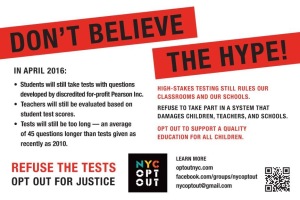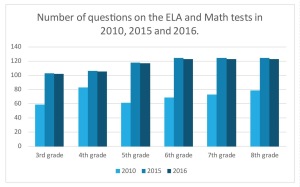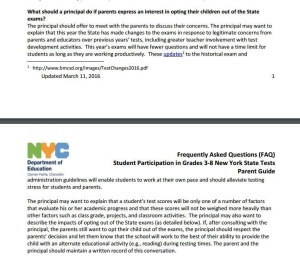Over the course of three consecutive days last week, students in grades 3-8 took Pearson’s New York State (NYS) Common Core English-language arts (ELA) tests. As was the case in 2013, 2014 and 2015, the 2016 ELA tests were developmentally inappropriate, confusing and tricky. Despite the New York State Education Department (NYSED)’s “adjustments” to the 2016 assessments, there was no improvement to the quality of the tests.
While I am barred from disclosing the reading passages and questions that appeared on the tests, in no way will I refrain from broadcasting to the world how outraged I continue to be – year after year – over New York’s oppressive testing regime. Since 2013, when Pearson’s Common Core tests were first administered in New York state, I’ve been documenting this nightmare on my blog.
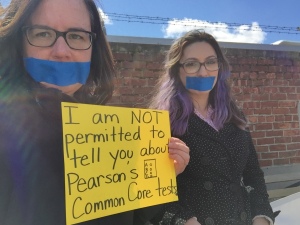
On 4/3/16, Lauren Cohen and I demonstrated at NYC councilman Danny Dromm’s rally in Jackson Heights, Queens. Dromm was informing parents of their right to opt-out of the NYS Common Core tests. As a member of the MORE caucus of the UFT, Lauren is running for VP of Elementary Schools in the upcoming UFT election. She truly puts children first.
Here are my thoughts on the 2016 ELA test. I have focused on third grade because these students – aged eight and nine – are our youngest NYS Common Core test-takers.
1.) The 2016 Common Core ELA test was as absurdly long as it was in 2013, 2014 and 2015 despite the fact that it was shortened by just one reading passage and by a handful of multiple choice questions.
2016 Grade 3 Common Core English Language Arts Test
- Day One: 4 reading passages, 24 multiple-choice questions (Students darken the circles on Answer Sheet 1).
- Day Two: 3 reading passages (same as 2015), 7 multiple-choice questions (Students darken the circles on Answer Sheet 2), 2 short-response questions (Students write answers directly in Book 2.) 1 extended-response question (Students write answer directly in Book 2).
- Day Three: 3 reading passages (same as 2015), 5 short-response questions (Students write answers directly in Book 3) and 1 extended-response question (Students write answer directly in Book 3).
TOTALS: 10 reading passages, 31 multiple-choice questions, 7 short-response questions and 2 extended-response questions.
For the short-response questions, students typically write a paragraph-long response that must include at least two details from the passage. The extended-response question requires an essay-like written response: introduction, supporting evidence/details, conclusion. Where is the NYSED’s research that shows that this is an educationally sound testing program for a third grader? Seriously. Does anyone know how the NYSED justifies this? The length alone of these tests warrants our banging of pots and pans in city streets.
2.) Now let’s move on to content. The reading passages were excerpts and articles from authentic texts (magazines and books). Pearson, the NYSED or Questar did a poor job of selecting and contextualizing the excerpts in the student test booklets. How many students actually read the one-to-two sentence summaries that appeared at the beginning of the stories? One excerpt in particular contained numerous characters and settings and no clear story focus. The vocabulary in the non-fiction passages was very technical and specific to topics largely unfamiliar to the average third grader. In other words, the passages were not meaningful. Many students could not connect the text-to-self nor could they tap into prior knowledge to facilitate comprehension.
3.) The questions were confusing. They were so sophisticated that it appeared incongruous to me to watch a third grader wiggle her tooth while simultaneously struggle to answer high school-level questions. How does one paragraph relate to another?, for example. Unfortunately, I can’t disclose more. The multiple-choice answer choices were tricky, too. Students had to figure out the best answer among four answer choices, one of which was perfectly reasonable but not the best answer. Here’s what P.S. 321’s principal, Elizabeth Phillips, wrote about the 2014 Common Core tests. Her op-ed We Need to Talk About the Test appeared in The New York Times on April 9, 2014. These same issues were evident on the third grade 2016 ELA test.
“In general terms, the tests were confusing, developmentally inappropriate and not well aligned with the Common Core standards. The questions were focused on small details in the passages, rather than on overall comprehension, and many were ambiguous. Children as young as 8 were asked several questions that required rereading four different paragraphs and then deciding which one of those paragraphs best connected to a fifth paragraph. There was a strong emphasis on questions addressing the structure rather than the meaning of the texts. There was also a striking lack of passages with an urban setting. And the tests were too long; none of us can figure out why we need to test for three days to determine how well a child reads and writes.”
4.) The reading levels of the passages were above “grade” level, whatever “grade” level means these days. One passage was an article recommended for students in grades 6-8. Has the NYSED done any research on early childhood education? Defending the Early Years cites a Gesell Institute of Child Development report that says,
“…the average age at which children learn to read independently is 6.5 years. Some begin as early as four years and some not until age seven or later – and all of this falls within the normal range.”
Yet for the NYS Common Core ELA test, the NYSED expects all third graders to be able to decode and comprehend texts that are typically used with fourth, fifth and sixth graders?
5.) While in theory I prefer untimed tests to timed tests, the lack of a time limit is of little comfort to students who are subjected to developmentally inappropriate tests. Read this heartbreaking account by a New York City teacher who blogs at pedagogyofthereformed.wordpress.com. Of a former student, this teacher writes,
“After 18 hours of testing over 3 days, she emerged from the classroom in a daze. I asked her if she was ok, and offered her a hug. She actually fell into my arms and burst into tears. I tried to cheer her up but my heart was breaking. She asked if she could read for a while in my room to calm down and then cried into her book for the next 15 minutes.”
Leonie Haimson, Executive Director of Class Size Matters, noted in a post on her blog NYC Public School Parents that this “…appears to violate the NY law passed in 2014 that limits state testing time to one percent of total instructional time.” Additionally, fellow Change the Stakes member, Rosalie Friend, pointed out that “without a set time limit, the tests no longer are standardized. Therefore, one cannot draw ANY conclusions from the scores.” So this alone seems to invalidate these $44 million tests.
Collectively, we must stop this insanity. I’ve been sounding the alarm on these tests since 2013, and the vast majority of educators I know agree with me. I’m beyond fed-up that I have to continue to administer these assessments to my students. It is unconscionable to me that Chancellor Fariña, in her 3/15/16 letter to NYC parents, wrote that these tests are “incredibly important” and a “valuable experience for our students.” It’s been nearly a month since I read those words and my jaw is still on the floor.
Parents – if you haven’t already refused the tests, you still have time to opt-out of the Common Core math tests, which will be administered on April 13, 14 and 15 of this week.
Teachers and administrators – the Common Core testing climate in New York state is too dire for you to remain quiet. Speak up and encourage parents to opt-out. Boycotting these tests is the only way to change course.
May this video of these principled MORE teachers inspire you.
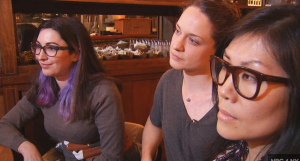
From left to right: NYC teachers Lauren Cohen, Kristin Taylor and Jia Lee spoke critically of the NYS Common Core tests to NBC 4 New York. Screenshot courtesy of NYC teacher and UFT chapter leader Arthur Goldstein who blogs at nyceducator.com.
For more information, please visit:
NYS Allies for Public Education




